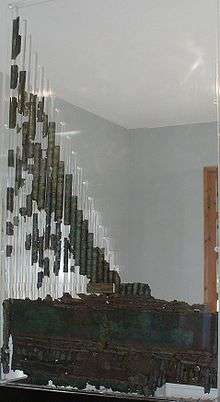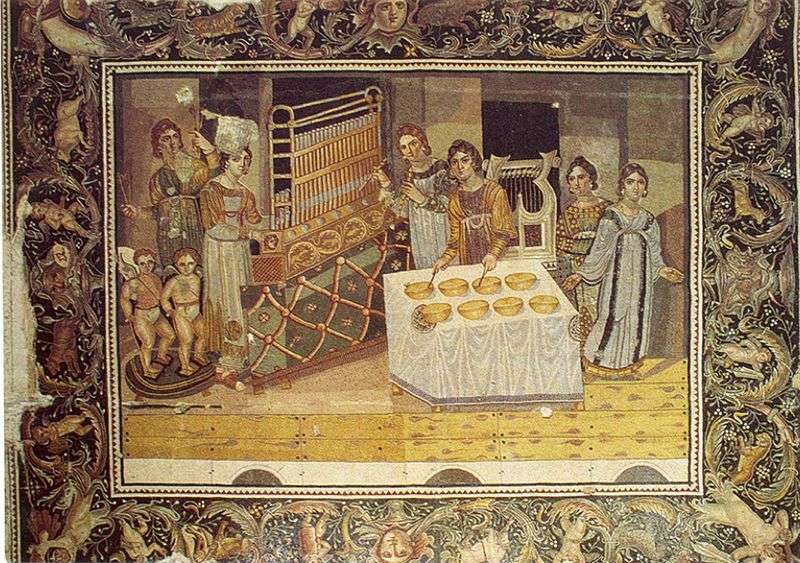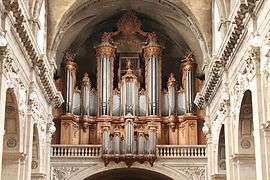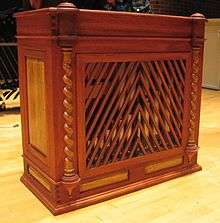Pipe organ
The pipe organ is a musical instrument that produces sound by driving pressurized air (called wind) through the organ pipes selected from a keyboard. Because each pipe produces a single pitch, the pipes are provided in sets called ranks, each of which has a common timbre and volume throughout the keyboard compass. Most organs have many ranks of pipes of differing timbre, pitch, and volume that the player can employ singly or in combination through the use of controls called stops.
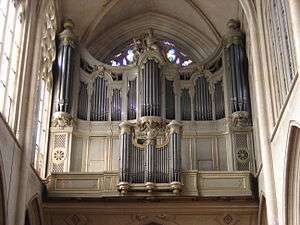 | |
| Other names | Organ, church organ |
|---|---|
| Classification | Keyboard instrument (Aerophone) |
| Developed | 3rd century BC |
| Playing range | |
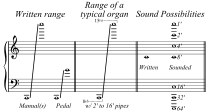 | |
| Related instruments | |
| see Organ | |
| Builders | |
| see List of pipe organ builders and Category:Pipe organ builders | |
A pipe organ has one or more keyboards (called manuals) played by the hands, and a pedalboard played by the feet; each keyboard controls its own division, or group of stops. The keyboard(s), pedalboard, and stops are housed in the organ's console. The organ's continuous supply of wind allows it to sustain notes for as long as the corresponding keys are pressed, unlike the piano and harpsichord whose sound begins to dissipate immediately after a key is depressed. The smallest portable pipe organs may have only one or two dozen pipes and one manual; the largest may have over 33,000 pipes and seven manuals.[2] A list of some of the most notable and largest pipe organs in the world can be viewed at List of pipe organs. A list consisting the ranking of the largest organs in the world - based on the criterion constructed by Michał Szostak, i.e. 'the number of ranks and additional equipment managed from a single console - can be found in 'The Organ'[3] and in 'The Vox Humana'.[4]
The origins of the pipe organ can be traced back to the hydraulis in Ancient Greece, in the 3rd century BC,[5] in which the wind supply was created by the weight of displaced water in an airtight container. By the 6th or 7th century AD, bellows were used to supply Byzantine organs with wind.[5][6] Beginning in the 12th century, the organ began to evolve into a complex instrument capable of producing different timbres. A pipe organ with "great leaden pipes" was sent to the West by the Byzantine emperor Constantine V as a gift to Pepin the Short, King of the Franks, in 757.[7] Pepin's son Charlemagne requested a similar organ for his chapel in Aachen in 812, beginning the pipe organ's establishment in Western European church music.[8] In England, "The first organ of which any detailed record exists was built in Winchester Cathedral in the 10th century. It was a huge machine with 400 pipes, which needed two men to play it and 70 men to blow it, and its sound could be heard throughout the city." [9] By the 17th century, most of the sounds available on the modern classical organ had been developed.[10] From that time, the pipe organ was the most complex man-made device[11] — a distinction it retained until it was displaced by the telephone exchange in the late 19th century.[12]
Pipe organs are installed in churches, synagogues, concert halls, schools, other public buildings and in private properties. They are used in the performance of classical music, sacred music, secular music, and popular music. In the early 20th century, pipe organs were installed in theaters to accompany the screening of films during the silent movie era; in municipal auditoria, where orchestral transcriptions were popular; and in the homes of the wealthy.[13] The beginning of the 21st century has seen a resurgence in installations in concert halls. The organ boasts a substantial repertoire, which spans over 500 years.[14]
History and development
Antiquity
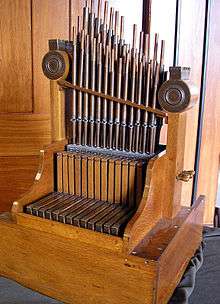
The organ is one of the oldest instruments still used in European classical music that has commonly been credited as having derived from Greece. Its earliest predecessors were built in Ancient Greece in the 3rd century BC. The word organ is derived from the Ancient Greek ὄργανον (órganon),[17] a generic term for an instrument or a tool,[18] via the Latin organum, an instrument similar to a portative organ used in ancient Roman circus games.
The Greek engineer Ctesibius of Alexandria is credited with inventing the organ in the 3rd century BC. He devised an instrument called the hydraulis, which delivered a wind supply maintained through water pressure to a set of pipes.[19] The hydraulis was played in the arenas of the Roman Empire. The pumps and water regulators of the hydraulis were replaced by an inflated leather bag in the 2nd century AD,[19] and true bellows began to appear in the Eastern Roman Empire in the 6th or 7th century AD.[5] Some 400 pieces of a hydraulis from the year 228 AD have been revealed during the 1931 archaeological excavations in the former Roman town Aquincum, province of Pannonia (present day Budapest), which was used as a music instrument by the Aquincum fire dormitory; a modern replica produces an enjoyable sound.
The 9th century Persian geographer Ibn Khurradadhbih (d. 911), in his lexicographical discussion of instruments, cited the urghun (organ) as one of the typical instruments of the Eastern Roman (Byzantine) Empire.[20] It was often used in the Hippodrome in the imperial capital of Constantinople. A Syrian visitor describes a pipe organ powered by two servants pumping "bellows like a blacksmith's" as being played while guests ate at the emperor's Christmas dinner in Constantinople in 911.[6] The first Western European pipe organ with "great leaden pipes" was sent from Constantinople to the West by the Byzantine emperor Constantine V as a gift to Pepin the Short King of the Franks in 757. Pepin's son Charlemagne requested a similar organ for his chapel in Aachen in 812, beginning its establishment in Western European church music.[21]
Medieval
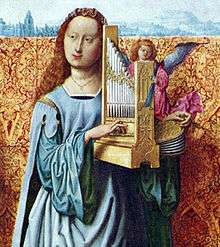
Portable organs (the portative and the positive organ) were invented in the Middle Ages. Towards the middle of the 13th century, the portatives represented in the miniatures of illuminated manuscripts appear to have real keyboards with balanced keys, as in the Cantigas de Santa Maria.[23] Its portability made the portative useful for the accompaniment of both sacred and secular music in a variety of settings.
In the 11th century, the monk Theophilus described in his treatise, known as Schedula diversarum artium ("List of various arts") or De diversis artibus ("On various arts"), all of the steps required for the construction of a church organ.[24] The instrument described by Theophilus was operated by a system of knobs and drones. Air pressure was maintained by stepping on air-filled hoses positioned at the player's feet.
Large organs such as the one installed in 1361 in Halberstadt, Germany,[25] the first documented permanent organ installation, likely prompted Guillaume de Machaut to describe the organ as "the king of instruments", a characterization still frequently applied.[26] The Halberstadt organ was the first instrument to use a chromatic key layout across its three manuals and pedalboard, although the keys were wider than on modern instruments.[27] It had twenty bellows operated by ten men, and the wind pressure was so high that the player had to use the full strength of his arm to hold down a key.[25]
Until the mid-15th century, organs had no stop controls. Each manual controlled ranks at many pitches, known as the Blockwerk.[28] Around 1450, controls were designed that allowed the ranks of the Blockwerk to be played individually. These devices were the forerunners of modern stop actions.[29] The higher-pitched ranks of the Blockwerk remained grouped together under a single stop control; these stops developed into mixtures.[30]
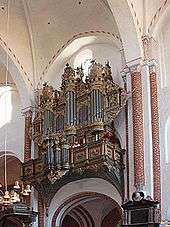
Renaissance and Baroque periods
During the Renaissance and Baroque periods, the organ's tonal colors became more varied. Organ builders fashioned stops that imitated various instruments, such as the krummhorn and the viola da gamba. Builders such as Arp Schnitger, Jasper Johannsen, Zacharias Hildebrandt and Gottfried Silbermann constructed instruments that were in themselves artistic masterpieces, displaying both exquisite craftsmanship and beautiful sound. These organs featured well-balanced mechanical key actions, giving the organist precise control over the pipe speech. Schnitger's organs featured particularly distinctive reed timbres and large Pedal and Rückpositiv divisions.[32]
Different national styles of organ building began to develop, often due to changing political climates.[33] In the Netherlands, the organ became a large instrument with several divisions, doubled ranks, and mounted cornets. The organs of northern Germany also had more divisions, and independent pedal divisions became increasingly common.[33] The divisions of the organ became visibly discernible from the case design. Twentieth-century musicologists have retroactively labelled this the Werkprinzip.[34]

In France, as in Italy, Spain and Portugal, organs were primarily designed to play alternatim verses rather than accompany congregational singing. The French Classical Organ, became remarkably consistent throughout France over the course of the Baroque era, more so than any other style of organ building in history, and standardized registrations developed.[35][36] It was elaborately described by Dom Bédos de Celles in his treatise L'art du facteur d'orgues (The Art of Organ Building).[37]
In England, many pipe organs were destroyed or removed from churches during the English Reformation of the 16th century and the Commonwealth period. Some were relocated to private homes. At the Restoration, organ builders such as Renatus Harris and "Father" Bernard Smith brought new organ-building ideas from continental Europe. English organs evolved from small one- or two-manual instruments into three or more divisions disposed in the French manner with grander reeds and mixtures, though still without pedal keyboards.[38] The Echo division began to be enclosed in the early 18th century, and in 1712 Abraham Jordan claimed his "swelling organ" at St Magnus-the-Martyr to be a new invention.[35] The swell box and the independent pedal division appeared in English organs beginning in the 18th century.[38][39]
Romantic period
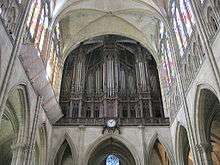
During the Romantic period, the organ became more symphonic, capable of creating a gradual crescendo. This was made possible by voicing stops in such a way that families of tone that historically had only been used separately could now be used together, creating an entirely new way of approaching organ registration. New technologies and the work of organ builders such as Eberhard Friedrich Walcker, Aristide Cavaillé-Coll, and Henry Willis made it possible to build larger organs with more stops, more variation in sound and timbre, and more divisions.[38] For instance, as earlier as in 1808, the first 32' contre-bombarde was installed in the great organ of Nancy Cathedral, France. Enclosed divisions became common, and registration aids were developed to make it easier for the organist to manage the great number of stops. The desire for louder, grander organs required that the stops be voiced on a higher wind pressure than before. As a result, a greater force was required to overcome the wind pressure and depress the keys. To solve this problem, Cavaillé-Coll configured the English "Barker lever" to assist in operating the key action. This is, essentially, a servomechanism that uses wind pressure from the air plenum, to augment the force that is exerted by the player's fingers.[40]
Organ builders began to lean towards specifications with fewer mixtures and high-pitched stops. They preferred to use more 8′ and 16′ stops in their specifications and wider pipe scales.[41] These practices created a warmer, richer sound than was common in the 18th century. Organs began to be built in concert halls (such as the organ at the Palais du Trocadéro in Paris), and composers such as Camille Saint-Saëns and Gustav Mahler used the organ in their orchestral works.
Modern development
The development of pneumatic and electro-pneumatic key actions in the late 19th century made it possible to locate the console independently of the pipes, greatly expanding the possibilities in organ design. Electric stop actions were also developed, which allowed sophisticated combination actions to be created.[42]
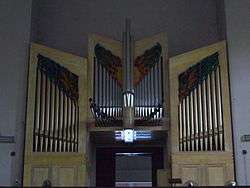
Beginning in the early 20th century in Germany and in the mid-20th century in the United States, organ builders began to build historically inspired instruments modeled on Baroque organs. They returned to building mechanical key actions, voicing with lower wind pressures and thinner pipe scales, and designing specifications with more mixture stops.[43] This became known as the Organ reform movement.
In the late 20th century, organ builders began to incorporate digital components into their key, stop, and combination actions. Besides making these mechanisms simpler and more reliable, this also makes it possible to record and play back an organist's performance using the MIDI protocol.[44] In addition, some organ builders have incorporated digital (electronic) stops into their pipe organs.
The electronic organ developed throughout the 20th century. Some pipe organs were replaced by digital organs because of their lower purchase price, smaller physical size, and minimal maintenance requirements. In the early 1970s, Rodgers Instruments pioneered the hybrid organ, an electronic instrument that incorporates real pipes; other builders such as Allen Organs and Johannus Orgelbouw have since built hybrid organs. Allen Organs first introduced the electronic organ in 1937 and in 1971 created the first digital organ using CMOS technology borrowed from NASA which created the digital pipe organ using sound recorded from actual speaking pipes and incorporating the sounds electronically within the memory of the digital organ thus having real pipe organ sound without the actual organ pipes.
Construction
A pipe organ contains one or more sets of pipes, a wind system, and one or more keyboards. The pipes produce sound when pressurized air produced by the wind system passes through them. An action connects the keyboards to the pipes. Stops allow the organist to control which ranks of pipes sound at a given time. The organist operates the stops and the keyboards from the console.
Pipes
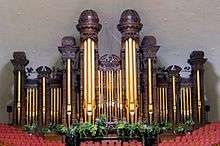
Organ pipes are made from either wood or metal[45] and produce sound ("speak") when air under pressure ("wind") is directed through them.[46] As one pipe produces a single pitch, multiple pipes are necessary to accommodate the musical scale. The greater the length of the pipe, the lower its resulting pitch will be.[47] The timbre and volume of the sound produced by a pipe depends on the volume of air delivered to the pipe and the manner in which it is constructed and voiced, the latter adjusted by the builder to produce the desired tone and volume. Hence a pipe's volume cannot be readily changed while playing.[47]
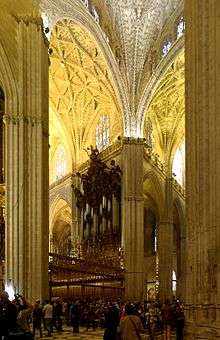
Organ pipes are divided into flue pipes and reed pipes according to their design and timbre. Flue pipes produce sound by forcing air through a fipple, like that of a recorder, whereas reed pipes produce sound via a beating reed, like that of a clarinet or saxophone.[48]
Pipes are arranged by timbre and pitch into ranks. A rank is a set of pipes of the same timbre but multiple pitches (one for each note on the keyboard), which is mounted (usually vertically) onto a windchest.[49] The stop mechanism admits air to each rank. For a given pipe to sound, the stop governing the pipe's rank must be engaged, and the key corresponding to its pitch must be depressed. Ranks of pipes are organized into groups called divisions. Each division generally is played from its own keyboard and conceptually comprises an individual instrument within the organ.[50]
Action
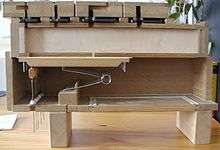
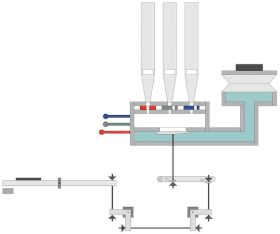
An organ contains two actions, or systems of moving parts. When a key is depressed, the key action admits wind into a pipe. The stop action allows the organist to control which ranks are engaged. An action may be mechanical, pneumatic, or electrical (or some combination of these, such as electro-pneumatic action).[51] The key action is independent of the stop action, allowing an organ to combine a mechanical key action along with an electric stop action.
A key action which physically connects the keys and the windchests is a mechanical or tracker action. Connection is achieved through a series of rods called trackers. When the organist depresses a key, the corresponding tracker pulls open its pallet, allowing wind to enter the pipe.[52]
In a mechanical stop action, each stop control operates a valve for a whole rank of pipes. When the organist selects a stop, the valve allows wind to reach the selected rank.[49] This control was at first a draw stop knob, which the organist selects by pulling (or drawing) toward himself/herself. This is the origin of the idiom "to pull out all the stops".[53] More modern stop selectors, utilized in electric actions, are tilting tablets or rocker tabs.
Tracker action has been used from antiquity to modern times. Before the pallet opens, wind pressure augments tension of the pallet spring, but once the pallet opens, only the spring tension is felt at the key. This provides a "breakaway" feel.[54]
A later development was the tubular-pneumatic action, which uses changes of pressure within lead tubing to operate pneumatic valves throughout the instrument. This allowed a lighter touch, and more flexibility in the location of the console, within a roughly 50-foot (15-m) limit. This type of construction was used in the late 19th century to early 20th century, and has had only rare application since the 1920s.[55]
A more recent development is the electric action which uses low voltage DC to control the key and/or stop mechanisms. Electricity may control the action indirectly through air pressure valves (pneumatics), in which case the action is electro-pneumatic. In such actions, an electromagnet attracts a small pilot valve which lets wind go to a bellows ("pneumatic") which opens the pallet. When electricity operates the action directly without the assistance of pneumatics, it is commonly referred to as direct electric action.[55] In this type, the electromagnet's armature carries a disc pallet.
When electrical wiring alone is used to connect the console to the windchest, electric actions allow the console to be separated at any practical distance from the rest of the organ, and to be movable.[56] Electric stop actions can be controlled at the console by stop knobs, by pivoted tilting tablets, or rocker tabs. These are simple switches, like wall switches for room lights. Some may include electromagnets for setting or resetting when combinations are selected.
The most innovations in organ control systems connect the console and windchests via narrow data cables instead of the larger bundles of cables. Embedded computers in the console and near the windchests communicate with each other via various complex multiplexing syntaxes, comparable to MIDI.
Wind system
The wind system consists of the parts that produce, store, and deliver wind to the pipes. Pipe organ wind pressures are on the order of 0.10 psi (0.69 kPa). Organ builders traditionally measure organ wind using a water U-tube manometer, which gives the pressure as the difference in water levels in the two legs of the manometer. The difference in water level is proportional to the difference in pressure between the wind being measured and the atmosphere.[57] The 0.10 psi above would register as 2.75 inches of water (70 mmAq). An Italian organ from the Renaissance period may be on only 2.2 inches (56 mm),[58] while (in the extreme) solo stops in some large 20th-century organs may require up to 50 inches (1,300 mm). In isolated, extreme cases, some stops have been voiced on 100 inches (2,500 mm).[59]
With the exception of water organs, playing the organ before the invention of motors required at least one person to operate the bellows. When signaled by the organist, a calcant would operate a set of bellows, supplying the organ with wind.[60] Because calcants were expensive, organists would usually practise on other instruments such as the clavichord or harpsichord.[61] By the mid-19th-century bellows were also being operated by water engines,[62] steam engines or gasoline engines.[63][64][65] Starting in the 1860s bellows were gradually replaced by rotating turbines which were later directly connected to electrical motors.[66] This made it possible for organists to practice regularly on the organ. Most organs, both new and historic, have electric blowers, although some can still be operated manually.[67] The wind supplied is stored in one or more regulators to maintain a constant pressure in the windchests until the action allows it to flow into the pipes.[68]
Stops
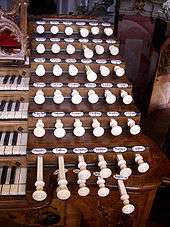
Each stop usually controls one rank of pipes, although mixtures and undulating stops (such as the Voix céleste) control multiple ranks.[69] The name of the stop reflects not only the stop's timbre and construction, but also the style of the organ in which it resides. For example, the names on an organ built in the north German Baroque style generally will be derived from the German language, while the names of similar stops on an organ in the French Romantic style will usually be French. Most countries tend to use only their own languages for stop nomenclature. English-speaking nations as well as Japan are more receptive to foreign nomenclature. Stop names are not standardized: two otherwise identical stops from different organs may have different names.[70]
To facilitate a large range of timbres, organ stops exist at different pitch levels. A stop that sounds at unison pitch when a key is depressed is referred to as being at 8′ (pronounced "eight-foot") pitch. This refers to the length of the lowest-sounding pipe in that rank, which is approximately eight feet (2.4 m). For the same reason, a stop that sounds an octave higher is at 4′ pitch, and one that sounds two octaves higher is at 2′ pitch. Likewise, a stop that sounds an octave lower than unison pitch is at 16′ pitch, and one that sounds two octaves lower is at 32′ pitch.[69] Stops of different pitch levels are designed to be played simultaneously.
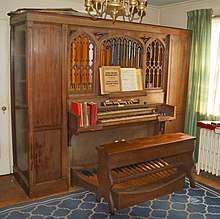
The label on a stop knob or rocker tab indicates the stop's name and its pitch in feet. Stops that control multiple ranks display a Roman numeral indicating the number of ranks present, instead of pitch.[71] Thus, a stop labelled "Open Diapason 8′ " is a single-rank diapason stop sounding at 8′ pitch. A stop labelled "Mixture V" is a five-rank mixture.
Sometimes, a single rank of pipes may be able to be controlled by several stops, allowing the rank to be played at multiple pitches or on multiple manuals. Such a rank is said to be unified or borrowed. For example, an 8′ Diapason rank may also be made available as a 4′ Octave. When both of these stops are selected and a key (for example, c′)[72] is pressed, two pipes of the same rank will sound: the pipe normally corresponding to the key played (c′), and the pipe one octave above that (c′′). Because the 8′ rank does not have enough pipes to sound the top octave of the keyboard at 4′ pitch, it is common for an extra octave of pipes used only for the borrowed 4′ stop to be added. In this case, the full rank of pipes (now an extended rank) is one octave longer than the keyboard.[73]
Special unpitched stops also appear in some organs. Among these are the Zimbelstern (a wheel of rotating bells), the nightingale (a pipe submerged in a small pool of water, creating the sound of a bird warbling when wind is admitted),[74] and the effet d'orage ("thunder effect", a device that sounds the lowest bass pipes simultaneously). Standard orchestral percussion instruments such as the drum, chimes, celesta, and harp have also been imitated in organ building.[75]
Console
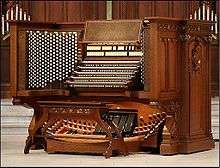
The controls available to the organist, including the keyboards, couplers, expression pedals, stops, and registration aids are accessed from the console.[77] The console is either built into the organ case or detached from it.
Keyboards
Keyboards played by the hands are known as manuals (from the Latin manus, meaning "hand"). The keyboard played by the feet is a pedalboard. Every organ has at least one manual (most have two or more), and most have a pedalboard. Each keyboard is named for a particular division of the organ (a group of ranks) and generally controls only the stops from that division. The range of the keyboards has varied widely across time and between countries. Most current specifications call for two or more manuals with sixty-one notes (five octaves, from C to c″″) and a pedalboard with thirty or thirty-two notes (two and a half octaves, from C to f′ or g′).[72][78]
Couplers
A coupler allows the stops of one division to be played from the keyboard of another division. For example, a coupler labelled "Swell to Great" allows the stops drawn in the Swell division to be played on the Great manual. This coupler is a unison coupler, because it causes the pipes of the Swell division to sound at the same pitch as the keys played on the Great manual. Coupling allows stops from different divisions to be combined to create various tonal effects. It also allows every stop of the organ to be played simultaneously from one manual.[79]
Octave couplers, which add the pipes an octave above (super-octave) or below (sub-octave) each note that is played, may operate on one division only (for example, the Swell super octave, which adds the octave above what is being played on the Swell to itself), or act as a coupler to another keyboard (for example, the Swell super-octave to Great, which adds to the Great manual the ranks of the Swell division an octave above what is being played).[79]
In addition, larger organs may use unison off couplers, which prevent the stops pulled in a particular division from sounding at their normal pitch. These can be used in combination with octave couplers to create innovative aural effects, and can also be used to rearrange the order of the manuals to make specific pieces easier to play.[79]
Enclosure and expression pedals
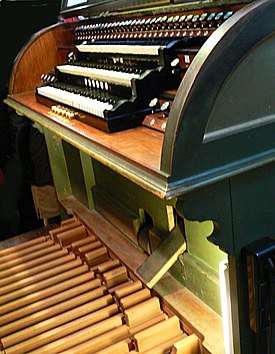
Enclosure refers to a system that allows for the control of volume without requiring the addition or subtraction of stops. In a two-manual organ with Great and Swell divisions, the Swell will be enclosed. In larger organs, parts or all of the Choir and Solo divisions may also be enclosed.[81] The pipes of an enclosed division are placed in a chamber generally called the swell box. At least one side of the box is constructed from horizontal or vertical palettes known as swell shades, which operate in a similar way to Venetian blinds; their position can be adjusted from the console. When the swell shades are open, more sound is heard than when they are closed.[81] Sometimes the shades are exposed, but they are often concealed behind a row of facade-pipes or a grill.
The most common method of controlling the louvers is the balanced swell pedal. This device is usually placed above the centre of the pedalboard and is configured to rotate away from the organist from a near-vertical position (in which the shades are closed) to a near-horizontal position (in which the shades are open).[82] An organ may also have a similar-looking crescendo pedal, found alongside any expression pedals. Pressing the crescendo pedal forward cumulatively activates the stops of the organ, starting with the softest and ending with the loudest; pressing it backwards reverses this process.[83]
Combination action
Organ stops can be combined in countless permutations, resulting in a great variety of sounds. A combination action can be used to switch instantly from one combination of stops (called a registration) to another. Combination actions feature small buttons called pistons that can be pressed by the organist, generally located beneath the keys of each manual (thumb pistons) or above the pedalboard (toe pistons).[84] The pistons may be divisional (affecting only a single division) or general (affecting all the divisions), and are either preset by the organ builder or can be altered by the organist. Modern combination actions operate via computer memory, and can store several channels of registrations.[85]
Casing
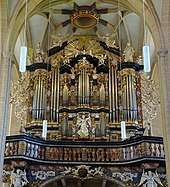
The pipes, action, and wind system are almost always contained in a case, the design of which also may incorporate the console. The case blends the organ's sound and aids in projecting it into the room.[86] The case is often designed to complement the building's architectural style and it may contain ornamental carvings and other decorations. The visible portion of the case, called the façade, will most often contain pipes, which may be either sounding pipes or dummy pipes solely for decoration. The façade pipes may be plain, burnished, gilded, or painted[87] and are usually referred to as (en) montre within the context of the French organ school.[88][89]
Organ cases occasionally feature a few ranks of pipes protruding horizontally from the case in the manner of a row of trumpets. These are referred to as pipes en chamade and are particularly common in organs of the Iberian peninsula and large 20th-century instruments.[90]
Many organs, particularly those built in the early 20th century, are contained in one or more rooms called organ chambers. Because sound does not project from a chamber into the room as clearly as from a freestanding organ case, enchambered organs may sound muffled and distant.[91] For this reason, some modern builders, particularly those building instruments specializing in polyphony rather than Romantic compositions, avoid this unless the architecture of the room makes it necessary.
Tuning and regulation
The goal of tuning a pipe organ is to adjust the pitch of each pipe so that they all sound in tune with each other. How the pitch of each pipe is adjusted depends on the type and construction of that pipe.
Regulation adjusts the action so that all pipes sound correctly. If the regulation is wrongly set, the keys may be at different heights, some pipes may sound when the keys are not pressed (a "cipher"), or pipes may not sound when a key is pressed. Tracker action, for example in the organ of Cradley Heath Baptist Church, includes adjustment nuts on the wire ends of the wooden trackers, which have the effect of changing the effective length of each tracker.
Repertoire
The main development of organ repertoire has progressed along with that of the organ itself, leading to distinctive national styles of composition. Because organs are commonly found in churches and synagogues, the organ repertoire includes a large amount of sacred music, which is accompanimental (choral anthems, congregational hymns, liturgical elements, etc.) as well as solo in nature (chorale preludes, hymn versets designed for alternatim use, etc.).[13] The organ's secular repertoire includes preludes, fugues, sonatas, organ symphonies, suites, and transcriptions of orchestral works.
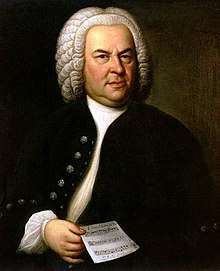
Although most countries whose music falls into the Western tradition have contributed to the organ repertoire, France and Germany in particular have produced exceptionally large amounts of organ music. There is also an extensive repertoire from the Netherlands, England, and the United States.
Before the Baroque era, keyboard music generally was not written for one instrument or another, but rather was written to be played on any keyboard instrument. For this reason, much of the organ's repertoire through the Renaissance period is the same as that of the harpsichord. Pre-Renaissance keyboard music is found in compiled manuscripts that may include compositions from a variety of regions. The oldest of these sources is the Robertsbridge Codex, dating from about 1360.[93] The Buxheimer Orgelbuch, which dates from about 1470 and was compiled in Germany, includes intabulations of vocal music by the English composer John Dunstaple.[94] The earliest Italian organ music is found in the Faenza Codex, dating from 1420.[95]
In the Renaissance period, Dutch composers such as Jan Pieterszoon Sweelinck composed both fantasias and psalm settings. Sweelinck in particular developed a rich collection of keyboard figuration that influenced subsequent composers.[96] The Italian composer Claudio Merulo wrote in the typical Italian genres of the toccata, the canzona, and the ricercar.[97] In Spain, the works of Antonio de Cabezón began the most prolific period of Spanish organ composition,[98] which culminated with Juan Cabanilles.
Early Baroque organ music in Germany was highly contrapuntal. Sacred organ music was based on chorales: composers such as Samuel Scheidt and Heinrich Scheidemann wrote chorale preludes, chorale fantasias, and chorale motets.[98] Towards the end of the Baroque era, the chorale prelude and the partita became mixed, forming the chorale partita.[99] This genre was developed by Georg Böhm, Johann Pachelbel, and Dieterich Buxtehude. The primary type of free-form piece in this period was the praeludium, as exemplified in the works of Matthias Weckmann, Nicolaus Bruhns, Böhm, and Buxtehude.[100] The organ music of Johann Sebastian Bach fused characteristics of every national tradition and historical style in his large-scale preludes and fugues and chorale-based works.[101] Towards the end of the Baroque era, George Frideric Handel composed the first organ concertos.[102]
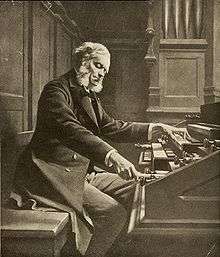
In France, organ music developed during the Baroque era through the music of Jean Titelouze, François Couperin, and Nicolas de Grigny.[104] Because the French organ of the 17th and early 18th centuries was very standardized, a conventional set of registrations developed for its repertoire. The music of French composers (and Italian composers such as Girolamo Frescobaldi) was written for use during the Mass. Very little secular organ music was composed in France and Italy during the Baroque period; the written repertoire is almost exclusively intended for liturgical use.[105] In England, composers such as John Blow and John Stanley wrote multi-sectional free works for liturgical use called voluntaries through the 19th century.[106][107]
Organ music was seldom written in the Classical era, as composers preferred the piano with its ability to create dynamics.[108] In Germany, the six sonatas op. 65 of Felix Mendelssohn (published 1845) marked the beginning of a renewed interest in composing for the organ. Inspired by the newly built Cavaillé-Coll organs, the French organist-composers César Franck, Alexandre Guilmant and Charles-Marie Widor led organ music into the symphonic realm.[108] The development of symphonic organ music continued with Louis Vierne and Charles Tournemire. Widor and Vierne wrote large-scale, multi-movement works called organ symphonies that exploited the full possibilities of the symphonic organ.[109] Max Reger and Sigfrid Karg-Elert's symphonic works made use of the abilities of the large Romantic organs being built in Germany at the time.[108]
In the 19th and 20th centuries, organ builders began to build instruments in concert halls and other large secular venues, allowing the organ to be used as part of an orchestra, as in Saint-Saëns' Symphony No. 3.[108] Frequently the organ is given a soloistic part, such as in Joseph Jongen's Symphonie Concertante for Organ & Orchestra, Francis Poulenc's Concerto for Organ, Strings and Tympani, and Frigyes Hidas' Organ Concerto.
Other composers who have used the organ prominently in orchestral music include Gustav Holst, Richard Strauss, Ottorino Respighi, Gustav Mahler, Anton Bruckner, and Ralph Vaughan Williams.[110] Because these concert hall instruments could approximate the sounds of symphony orchestras, transcriptions of orchestral works found a place in the organ repertoire.[111] As silent films became popular, theatre organs were installed in theatres to provide accompaniment for the films.[108]
In the 20th-century symphonic repertoire, both sacred and secular,[112] continued to progress through the music of Marcel Dupré, Maurice Duruflé, and Herbert Howells.[108] Other composers, such as Olivier Messiaen, György Ligeti, Jehan Alain, Jean Langlais, Gerd Zacher, and Petr Eben, wrote post-tonal organ music.[108] Messiaen's music in particular redefined many of the traditional notions of organ registration and technique.[113]
Notes
- Organ built by François-Henri Clicquot, 1771 and Joseph Merklin, 1864. Poliquin, Robert (1997). Organs in France: Église Saint-Germain-l'Auxerrois, Paris Archived 2009-01-16 at the Wayback Machine. Retrieved on 2008-03-03.
- Willey, David (2001). "The World's Largest Organs". Retrieved on 2008-03-03.
- Szostak, Michał (November 2017 – January 2018). "The World's Largest Organs". The Organ. The Musical Opinion Ltd. 382: 12–28. ISSN 0030-4883.CS1 maint: date format (link)
- Szostak, Michał (September 30, 2018). "The Largest Pipe Organs in the World". Vox Humana.
- Randel "Organ", 583.
- Dalby, Andrew Taste of Byzantium. IB Tauris, 2010, ISBN 9781848851658, p. 118. "the narrative of the Syrian hostage Harun Ibn Yahya...'This is what happens at Christmas...they bring what is called an organon. It is a remarkable wooden object like an oil-press, and covered with solid leather. Sixty copper pipes are placed in it, so that they project above the leather, and where they are visible above the leather they are gilded. You can only see a small part of some of them, as they are of different lengths. On one side of this structure there is a hole in which they place a bellows like a blacksmith's. three crosses are placed at the two extremities and in the middle of the organon. Two men come in to work the bellows, and the master stands and bidding to press on the pipes, and each pipe, according to its tuning and the master's playing, sounds the parsed of the Emperor. The guests are meanwhile seated at their tables, and twenty men enter with cymbals in their hands. The miscue continues while the guests continue their meal.' "
- Willis, Henry. "The Organ, Its History and Development." Proceedings of the Royal Musical Association. Vol. 73. No. 1. Taylor & Francis Group, 1946. p. 60
- Douglas Bush and Richard Kassel eds., "The Organ, an Encyclopedia." Routledge. 2006. p. 327.
- Winchester Cathedral http://www.winchester-cathedral.org.uk/worship-and-music/music-choir/the-cathedral-organ/.
- Randel "Organ", 584–585.
- Michael Woods, "Strange ills afflict pipe organs of Europe". Post-Gazette, April 26, 2005. Archived February 22, 2012, at the Wayback Machine
- N. Pippenger, "Complexity Theory", Scientific American, 239:90-100 (1978).
- Smith, Rollin (1998). The Aeolian pipe organ and its music. Richmond VA USA: The Organ Historical Society. ISBN 0-913499-16-1.
- Thomas, Steve, 2003. Pipe organs 101: an introduction to pipe organ basics. Retrieved on 2007-05-06.
- "The Museums of Macedonia:Archaeological Museum of Dion". Macedonian Heritage. Retrieved August 28, 2009.
- Ring, Trudy (1994), International Dictionary of Historic Places: Middle East and Africa, 4, Taylor & Francis, ISBN 1884964036
- Harper, Douglas (2001). Organ. Online Etymology Dictionary. Retrieved on 2008-02-10.
- Liddell, Henry George & Scott, Robert (1940). Organon. A Greek-English Lexicon. Oxford: Clarendon Press. ISBN 0-19-864226-1. Perseus. Retrieved on 2008-02-09.
- Randel "Hydraulis", 385.
- Kartomi, Margaret J. (1990), On Concepts and Classifications of Musical Instruments, University of Chicago Press, p. 124, ISBN 0-226-42548-7
- Douglas Bush and Richard Kassel eds., "The Organ, an Encyclopedia." Routledge. 2006. p. 327. Extract of page 327
- Painting by Meister des Bartholomäus-Altars, 1501.
- Riaño, J. F. (1887). Critical and Bibliographical Notes on Early Spanish Music (PDF). London: Quaritch, 119–127. ISBN 0-306-70193-6.
- Smith, C.S.; Hawthorne, J.G. Theophilus: On Divers Arts. University of Chicago Press, 1963; reprinted New York: Dover Publications 1979.
- Kennedy, Michael (Ed.) (2002). "Organ". In The Oxford Dictionary of Music, p. 644. Oxford: Oxford University Press.
- Sumner "The Organ", 39.
- Keyboard instrument (2008). In Encyclopædia Britannica Online (subscription required, though relevant reference is viewable in concise article). Retrieved on 2008-01-26.
- Douglass, 10–12.
- Thistlethwaite, 5.
- Phelps, Lawrence (1973). "A brief look at the French Classical organ, its origins and German counterpart". Steve Thomas. Retrieved on 2007-05-07.
- Organ by Hermean Raphaelis, 1554. Copenhagen Portal: Roskilde Cathedral. GBM MARKETING ApS. Retrieved on 2008-05-13.
- Webber, 222.
- Randel "Organ", 585.
- Bicknell "The organ case", 66–71.
- Thistlethwaite, 12.
- Douglass, 3.
- (in French) Bédos de Celles, Dom François (1766). Extraits de l'Art du facteur d'orgues. Ferguson (Tr.) (1977). Retrieved on 2007-05-07.
- Randel "Organ", 586–587.
- McCrea, 279–280.
- Randel "Organ", 586.
- "The decline of mixtures," in George Laing Miller (1913), The Recent Revolution in Organ Building. Retrieved on 2009-07-07.
- Thistlethwaite, 14–15.
- Bicknell "Organ building today", 82ff.
- Retrieved on 2009-07-07.
- see Wikipedia: Organ_pipe and Materials heading
- Randel "Organ", 578.
- Randel "Organ", 579.
- Bicknell "Organ construction", 27.
- Bicknell "Organ construction", 20.
- Gleason, 3–4.
- William H. Barnes "The Contemporary American Organ"
- Bicknell "Organ construction", 22–23.
- "Answers.com: Pull out all the stops". Draw knobs were the only type of stop control in past centuries, and are still used.American Heritage Dictionary of Idioms. Houghton Mifflin Company (1992). Retrieved on 2007-05-06.
- The Physics of Organ Actions, Part 1: Mechanical Actions, "Fore-touch weight"
- William H. Barnes, "The Contemporary American Organ"
- Bicknell "Organ construction", 23–24.
- Douglas M. Considine, ed. (1974). Process Instruments and Controls Handbook (Second ed.). McGraw-Hill. pp. 3–4. ISBN 0-07-012428-0.
- Dalton, 168.
- The Boardwalk Hall Auditorium Organ in Atlantic City has four stops on 100 inches and ten stops on 50. Atlantic City Convention Hall Organ. Oddmusic.com. Retrieved on 2007-07-04.
- Bicknell "Organ construction", 18.
- Koopman, Ton (1991). "Dietrich Buxtehude's organ works: A practical help". The Musical Times 123 (1777) (subscription required, though relevant reference is viewable in preview). Retrieved on 2007-05-22.
- "Water Engines: Page 6". Douglas-self.com. 2011-06-10. Retrieved 2011-10-22.
- "St Jude's: History Pipe Organ". Bowralanglican.org.au. Archived from the original on 2009-10-13. Retrieved 2011-10-22.
- "Antwerpse Kathedraalconcerten vzw". Akc-orgel.be. Retrieved 2011-10-22.
- "organ blowers 3". Nzorgan.com. 1997-07-26. Archived from the original on 2011-09-27. Retrieved 2011-10-22.
- Sefl, 70-71
- About Opus 72 Archived 2008-12-05 at the Wayback Machine. C. B. Fisk, Inc.. Retrieved on 2008-05-13.
- Bicknell "Organ construction", 18–20.
- Bicknell "Organ construction", 26–27.
- Bicknell "Organ construction", 27–28.
- Johnson, David N. (1973). Instruction Book for Beginning Organists. Revised edition. Augsburg Fortress. p. 9. ISBN 978-0-8066-0423-7. Google Book search. Retrieved on 2008-08-15.
- This article uses the Helmholtz pitch notation to indicate specific pitches.
- The purpose of extended ranks and of their being borrowed is to save on the number of pipes. For example, without unification, three stops may use 183 pipes. With unification three stops may borrow one extended rank of 85 pipes. That's 98 fewer pipes used for those three stops.
- Randel "Rossignol", 718.
- Ahrens, 339; Kassel, 526-527
- Organ built by M. P. Moller, 1940. USNA Music Department. United States Naval Academy. Retrieved on 2008-03-04.
- Pipe Organ Guide Archived 2008-08-01 at the Wayback Machine. American Guild of Organists. Retrieved on 2008-08-13.
- Pipe Organ Guide Archived 2007-09-27 at the Wayback Machine. American Guild of Organists. Retrieved on 2007-06-25.
- "A brief tour of a pipe organ". Crumhorn Labs. Archived from the original on April 10, 2008. Retrieved 2008-04-19.
- Organ built by Wilhelm Schwarz, 1901
- Wicks "Swell division", "Swell shades".
- Wicks "Expression pedals".
- Wicks "Crescendo pedal".
- Pipe Organ Guide Archived 2010-07-07 at the Wayback Machine. American Guild of Organists. Retrieved on 2008-08-13.
- Electronic setter Archived 2009-05-11 at the Wayback Machine. The Cinema Organ Society. Retrieved on 2009-07-07.
- Randel "Organ", 580.
- Kassel, 146.
- PETER WILLIAMS, BARBARA OWEN, New Grove Dictionary of Music and Musicians, ORGAN STOP: Montre (Fr.). The case pipes of the French organ, corresponding to the English Open Diapason, the German Prestant, the Italian Principale, etc. Early alternative names were ‘le principal de devant’, ‘devanture en monstre’ (Reims Cathedral, 1570). The tone of the classical French Montre was somewhat more fluty than the various English Open Diapason types or German Principals.
- G.A. AUDSLEY Art of Organ-Building, Vol. I, p.544 ISBN 0-486-21314-5: MONTRE, Fr. -The name commonly applied by the French organ builders to such foundations and organ-toned metal stops as may be mounted or displayed in the buffet or case of an organ; accordingly, the MONTRES, which are usually of burnished tin, may be of 32 ft., 16 ft., and 8 ft. speaking lengths, as in the Organ in the Royal Church at Saint Denis near Paris. Sometimes the name is applied to the PRESTANT 4 ft., when its pipes are mounted. All the MONTRES are most carefully fashioned and finished, producing, when of tin brightly burnished, a beautiful effect in combination with the dark wood-work of the case.
- Bicknell "The organ case", 66–67.
- Wicks "Organ Chamber".
- Portrait by Elias Gottlob Haussmann, c.1748
- Caldwell, John (2007). "Sources of keyboard music to 1660, §2: Individual sources". In L. Macy (Ed.), Grove Music Online (subscription required). Retrieved on 2008-05-07.
- Cox, 190.
- Stembridge, 148.
- Webber, 224.
- Stembridge, 160.
- Caldwell, John (2007). "Keyboard music, §I: Keyboard music to c1750". In L. Macy (Ed.), Grove Music Online (subscription required). Retrieved on 2008-05-08.
- McLean, Hugh J. (2007). "Böhm, Georg". In L. Macy (Ed.), Grove Music Online (subscription required). Retrieved on 2008-05-08.
- Ledbetter, David (2007). "Prelude". In L. Macy (Ed.), Grove Music Online (subscription required). Retrieved on 2008-05-08.
- Yearsley, David (1999). "The organ music of J. S. Bach". In Nicholas Thistlethwaite & Geoffrey Webber (Eds.), The Cambridge Companion to the Organ, p. 236. Cambridge: Cambridge University Press.
- Lang, Paul Henry (1971). "Michael Haydn: Duo Concertante for viola and organ. Joseph Haydn: Organ Concerto in C major". The Musical Quarterly 57 (1). Retrieved on 2007-07-10.
- Portrait by Jeanne Rongier, 1888.
- Higginbottom, 177, 189.
- Higginbottom, 178–181.
- Cox, 198.
- McCrea, 279.
- Owen, Barbara (2007). "Keyboard music, §II: Organ music from c1750". In L. Macy (Ed.), Grove Music Online (subscription required). Retrieved on 2008-05-08.
- Brooks, Gerard (1999). "French and Belgian organ music after 1800". In Nicholas Thistlethwaite & Geoffrey Webber (Eds.), The Cambridge Companion to the Organ, pp. 274–275. Cambridge: Cambridge University Press.
- Barone, Michael (2004). "Pipe organs are popping up in concert halls nationwide. Now—what to play on them?". Symphony magazine, Nov–Dec 2004. Retrieved on 2007-05-07.
- Lozenz, James Edward (2006). "Organ Transcriptions and the Late Romantic Period". In An Organ Transcription of the Messe in C, op. 169 by Josef Gabriel Rheinberger Archived 2007-09-27 at the Wayback Machine (PDF). Florida State University College of Music. Retrieved on 2007-06-19.
- Glück, Sebastian Matthäus (2003). "Literature-based reed assignment in organ design". PIPORG-L. Retrieved on 2007-06-19.
- Galuska, Andrew R. (2001). "Messiaen's organ registration". Moore's School of Music: University of Houston. Retrieved on 2007-06-19.
References
- Ahrens, Christian (2006). In Bush, Douglas & Kassel, Richard (Eds.), The Organ: an Encyclopedia, pp. 399–499. New York: Routledge. ISBN 0-415-94174-1
- Audsley, G.A. Art of Organ-Building New York: Dover Publications. ISBN 0-486-21314-5:
- Bicknell, Stephen (1999). "Organ building today". In Thistlethwaite, Nicholas & Webber, Geoffrey (Eds.), The Cambridge Companion to the Organ, pp. 82–92. Cambridge: Cambridge University Press. ISBN 0-521-57584-2
- Bicknell, Stephen (1999). "Organ construction". In Thistlethwaite, Nicholas & Webber, Geoffrey (Eds.), The Cambridge Companion to the Organ, pp. 18–30. Cambridge: Cambridge University Press. ISBN 0-521-57584-2
- Bicknell, Stephen (1999). "The organ case". In Thistlethwaite, Nicholas & Webber, Geoffrey (Eds.), The Cambridge Companion to the Organ, pp. 55–81. Cambridge: Cambridge University Press. ISBN 0-521-57584-2
- Cox, Geoffrey (1999). "English organ music to c1700". In Thistlethwaite, Nicholas & Webber, Geoffrey (Eds.), The Cambridge Companion to the Organ, pp. 109–203. Cambridge: Cambridge University Press. ISBN 0-521-57584-2
- Dalton, James (1999). "Iberian organ music before 1700". In Thistlethwaite, Nicholas & Webber, Geoffrey (Eds.), The Cambridge Companion to the Organ, pp. 165–175. Cambridge: Cambridge University Press. ISBN 0-521-57584-2
- Douglass, Fenner (1995). The Language of the Classical French Organ. New Haven: Yale University Press. ISBN 978-0-300-06426-1
- Gleason, Harold (1988). Method of Organ Playing (7th ed.). Edited by Catherine Crozier Gleason. Englewood Cliffs, New Jersey: Prentice Hall. ISBN 0-13-579459-5
- Higginbottom, Edward (1999). "The French classical organ school". In Thistlethwaite, Nicholas & Webber, Geoffrey (Eds.), The Cambridge Companion to the Organ, pp. 176–189. Cambridge: Cambridge University Press. ISBN 0-521-57584-2
- Kassel, Richard (2006). Display pipes. In Bush, Douglas & Kassel, Richard (Eds.), The Organ: an Encyclopedia, pp. 145–146. New York: Routledge. ISBN 0-415-94174-1
- Kassel, Richard (2006). Sound effects. In Bush, Douglas & Kassel, Richard (Eds.), The Organ: an Encyclopedia, pp. 526–527. New York: Routledge. ISBN 0-415-94174-1
- McCrea, Andrew (1999). "British organ music after 1800". In Thistlethwaite, Nicholas & Webber, Geoffrey (Eds.), The Cambridge Companion to the Organ, pp. 279–298. Cambridge: Cambridge University Press. ISBN 0-521-57584-2
- Randel, Don Michael (Ed.) (1986). The New Harvard Dictionary of Music. Cambridge: Harvard University Press. ISBN 0-674-61525-5
- Sefl, Alfred (2006). Blower. In Bush, Douglas & Kassel, Richard (Eds.), The Organ: an Encyclopedia, pp. 70–71. New York: Routledge. ISBN 0-415-94174-1
- Stembridge, Christopher (1999). Italian organ music to Frescobaldi. In Thistlethwaite, Nicholas & Webber, Geoffrey (Eds.), The Cambridge Companion to the Organ, pp. 148–163. Cambridge: Cambridge University Press. ISBN 0-521-57584-2
- Sumner, William Leslie (1973). The Organ: Its Evolution, Principles of Construction and Use. London: Macdonald. ISBN 0-356-04162-X
- Thistlethwaite, Nicholas (1999). "Origins and development of the organ". In Thistlethwaite, Nicholas & Webber, Geoffrey (Eds.), The Cambridge Companion to the Organ, pp. 1–17. Cambridge: Cambridge University Press. ISBN 0-521-57584-2
- Webber, Geoffrey (1999). "The north German organ school". In Thistlethwaite, Nicholas & Webber, Geoffrey (Eds.), The Cambridge Companion to the Organ, pp. 219–235. Cambridge: Cambridge University Press. ISBN 0-521-57584-2
Further reading
- Adlung, Jacob (1768). Musica mechanica organoedi. English translation, Q. Faulkner, trans (2011). Lincoln, NE: Zea E-Books.
- Bédos de Celles, Dom François (1768). L'art du facteur d'orgues. Charles Ferguson (Trans.) (1977). The Organ-Builder. Raleigh, NC: Sunbury Press.
- Bush, Douglas and Kassel, Richard (Ed.) (2006). The Organ: An Encyclopedia. New York: Routledge. ISBN 978-0-415-94174-7
- Klotz, Hans (1969). The Organ Handbook. St. Louis: Concordia. ISBN 978-0-570-01306-8
- Ochse, Orpha (1975). The History of the Organ in the United States. Bloomington: Indiana University Press.
- Praetorius, Michael (1619). De Organographia, Parts III – V with Index (English translation)
- Soderlund, Sandra (1994). A Guide to the Pipe Organ for Composers and Others. Colfax, North Carolina: Wayne Leupold Editions. No ISBN.
- Sumner, William L. (1973). The Organ: Its evolution, principles of construction and use (4th ed.). London: MacDonald. No ISBN.
- Williams, Peter (1966). The European Organ, 1458–1850. Bloomington: Indiana University Press. ISBN 0-253-32083-6
- Williams, Peter (1980). A New History of the Organ from the Greeks to the Present Day. Bloomington: Indiana University Press. ISBN 978-0-253-15704-1
External links
| Wikimedia Commons has media related to Pipe organ. |
| Wikisource has the text of the 1911 Encyclopædia Britannica article Organ. |
- The Pipe Organ, a basic overview of the organ
- The Organ, quarterly UK publication about pipe organs
- ellykooiman.com, pipe organ website with information and detailed photos of various organs
- Sonderlund, Sandra. "A Young Person's Guide to the Pipe Organ". Archived from the original on 2013-12-20.
- Flue Pipe Acoustics, a scholarly description of flue pipe physics
- Organ transcriptions and the Late Romantic Period
- Organs and Organists, a repository of information on significant organs and organ builders
- Orgelgalerie, a gallery of over 2000 pipe organ pictures from many different countries
- Encyclopedia of Organ Stops, a comprehensive database of over 2500 stops with descriptions, pictures, and sound clips
- An introductory site to the organ particularly this Glossary of Organ Terms
Databases
- International Organ Foundation, an online pipe organ database with specifications of more than 10,000 organs in 95 countries
- Organ Historical Society Pipe Organ Database
- The Top 20 - The World's Largest Pipe Organs
- National Pipe Organ Register, featuring history and specifications of 28,000 pipe organs in the United Kingdom
- Die Orgelseite, photos and specifications of some of the world's most interesting organs (subscription required for some content)
- Organ Database, stoplists, pictures and information about some 33,500 pipe organs around the world
- The New York City Organ Project documents organs present and past in the five boroughs of New York City
- Musiconis Database, an online database of medieval musical iconography (featuring images of medieval organs)
Resources for pipe organ video recordings
- "TourBus to the King of Instruments" – video series with Carol Williams (organist) about the large & small, famous & unique pipe organs of the world. American Video & Audio Production Company
- "The Joy of Music" – television series with Diane Bish about large pipe organs in USA and in Europe.
